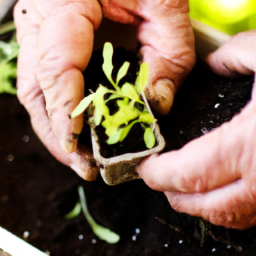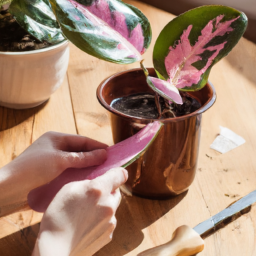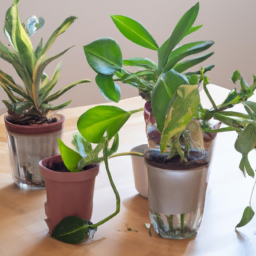
Are you looking to expand your indoor plant collection without breaking the bank? Look no further than division propagation: the secret to multiplying your indoor plant collection! Division propagation is a simple and cost-effective method that allows you to create new plants by separating the root ball of an existing one. Whether you’re a seasoned plant enthusiast or just starting your green journey, this blog post will provide you with all the information you need to successfully propagate your indoor plants through division. Get ready to unlock the potential of your plant collection and watch it flourish like never before!
Benefits of Division Propagation for Indoor Plants
Indoor plants not only enhance the aesthetic appeal of our living spaces but also contribute to our well-being by purifying the air and reducing stress levels. As plant enthusiasts, we often seek ways to expand our indoor plant collection without spending a fortune. One effective and cost-efficient method is division propagation. In this article, we will explore the numerous benefits of division propagation for indoor plants and provide you with a step-by-step guide to help you multiply your plant collection.
1. Increased Plant Quantity
Division propagation allows you to multiply your indoor plant collection significantly. By dividing a mature plant into multiple smaller sections, each with its own root system, you can create new individual plants. This method enables you to expand your collection without having to purchase new plants, making it a budget-friendly option for plant enthusiasts.
Additionally, division propagation is particularly advantageous for plants that are difficult to propagate through other methods, such as leaf or stem cuttings. By dividing the plant, you ensure a higher success rate in obtaining new plants, providing you with a greater variety of indoor greenery to enjoy.
Moreover, if you have a favorite plant that you wish to have in multiple locations within your home, division propagation allows you to achieve this without having to buy duplicates. It offers you the opportunity to distribute your beloved plants throughout various rooms, creating a harmonious and cohesive indoor garden.
2. Healthier and Stronger Plants
Another significant benefit of division propagation is the promotion of healthier and stronger plants. Over time, indoor plants may become root-bound, meaning their roots outgrow the current pot or container. This can lead to stunted growth, nutrient deficiencies, and an overall decline in plant health.
By dividing the plant and providing it with fresh soil and space to grow, you rejuvenate its root system and promote optimal growth. Each divided section will develop a new root system, allowing the plant to absorb nutrients more efficiently and establish itself in its new environment. As a result, your plants will flourish, exhibiting vibrant foliage and robust growth.
Furthermore, division propagation also helps prevent the spread of diseases or pests. By separating and inspecting each divided section, you can identify and address any potential issues before they affect the entire plant collection. This proactive approach ensures the overall health and longevity of your indoor plants.
3. Sharing and Gifting Opportunities
Division propagation not only benefits your own indoor plant collection but also presents opportunities for sharing and gifting plants to friends and family. As you multiply your plants through division, you will often end up with more than you need. Instead of letting them go to waste, you can share the joy of indoor gardening with others.
Giving away divided plants not only fosters a sense of community but also allows you to spread the beauty and benefits of indoor plants to those around you. Whether it’s a small potted plant for a coworker’s desk or a larger plant to brighten up a friend’s living room, the act of sharing plants can bring happiness and positivity to both the giver and the receiver.
Moreover, by gifting divided plants, you encourage others to explore the world of indoor gardening and experience the numerous benefits it offers. It can inspire a newfound passion and appreciation for plants, leading to a greener and more sustainable future for all.

Step-by-Step Guide to Division Propagation: Multiplying Your Indoor Plant Collection
Indoor plants not only add beauty and freshness to your living space but also provide numerous health benefits. If you’re a plant enthusiast looking to expand your indoor plant collection without spending a fortune, division propagation is a fantastic technique to consider. This method allows you to multiply your existing plants by separating them into smaller sections and planting them individually. In this step-by-step guide, we will walk you through the process of division propagation, ensuring a successful and thriving indoor plant collection.
1. Choose the Right Time
Timing is crucial when it comes to division propagation. The ideal time to divide most indoor plants is during the spring or early summer when they are actively growing. This allows the divided sections to establish themselves quickly and adapt to their new environment. However, it’s important to research the specific plant species you wish to propagate, as some may have different preferences in terms of timing.
Before proceeding with division propagation, make sure your plant is healthy and free from any diseases or pests. A weakened or stressed plant may struggle to recover from the process, so it’s best to choose a robust and thriving specimen for division.
Prepare all the necessary tools and materials beforehand, including clean pruning shears or a sharp knife, pots or containers, fresh potting soil, and a watering can. Having everything ready will make the process smoother and more efficient.
2. Prepare Your Plant
Start by removing the plant from its current pot or container. Gently tap the sides of the pot to loosen the root ball, and then carefully slide the plant out. If the plant is tightly rooted, you may need to use a knife to help loosen the roots without causing damage. Once the plant is out of the pot, gently shake off excess soil to expose the root system.
Inspect the root system for any signs of disease or damage. If you notice any unhealthy or rotting roots, trim them off with clean pruning shears or a sharp knife. It’s essential to have a healthy root system to ensure successful division propagation.
Depending on the size of the plant and the number of divisions you want to create, you may need to divide the root ball into two or more sections. Carefully separate the sections, ensuring that each division has an adequate amount of roots and foliage to survive on its own.
3. Plant the Divisions
Once you have divided your plant, it’s time to plant the individual sections into their new pots or containers. Choose pots that are slightly larger than the root system to allow room for growth. Fill each pot with fresh potting soil, leaving enough space at the top for watering.
Make a small hole in the center of each pot and gently place the division into it. Ensure that the roots are spread out and not crowded or tangled. Gently press the soil around the roots to secure the division in place. Repeat this process for each section you have divided.
After planting, give the divisions a thorough watering to settle the soil and promote root establishment. Water until you see water draining out from the bottom of the pots. Place the newly potted divisions in a suitable location with the right amount of light and temperature for their specific needs.
4. Provide Proper Care
Proper care is essential for the success of your newly divided plants. Ensure they receive adequate sunlight or shade, depending on their requirements. Most indoor plants thrive in bright, indirect light, away from direct sunlight. Monitor the moisture levels in the soil and water accordingly, allowing the top inch of soil to dry out before watering again.
Regularly check for any signs of pests or diseases and take appropriate action if necessary. Fertilize the plants with a balanced indoor plant fertilizer according to the instructions on the packaging. This will provide them with the necessary nutrients for healthy growth.
As the divisions grow and establish themselves, you may need to repot them into larger containers to accommodate their expanding root systems. This is usually required every 1-2 years, depending on the plant’s growth rate.
By following these step-by-step instructions, you can successfully propagate your indoor plants through division propagation. With a little patience and care, you’ll soon have a thriving collection of plants that will bring life and beauty to your indoor space.
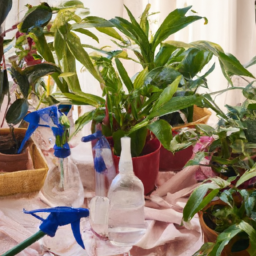
Common Mistakes to Avoid when Division Propagating Indoor Plants
Introduction
Propagation through division is a popular and effective method for multiplying your indoor plant collection. It involves separating a mature plant into smaller sections, each with its own root system, to create new individual plants. While division propagation may seem straightforward, there are common mistakes that many beginners make. In this guide, we will explore these mistakes and provide you with valuable insights on how to avoid them, ensuring successful division propagation for your indoor plants.
1. Choosing the Wrong Time
Timing is crucial when it comes to division propagation. Many plant enthusiasts make the mistake of dividing their plants at the wrong time, which can lead to stress and potential failure. It is essential to understand the growth cycle of your specific plant species and choose the right time to divide.
Generally, the best time to divide most indoor plants is during their active growth period, which is typically in the spring or early summer. During this time, plants have sufficient energy reserves and are more likely to recover quickly from the division process. Dividing during the dormant season or when the plant is blooming can hinder its ability to bounce back.
Before dividing, closely observe your plant for signs of new growth or increased vigor. This indicates that it is in a healthy state and ready for division. Remember, patience is key, and dividing at the right time will greatly increase the chances of success.
2. Neglecting Proper Preparation
Another common mistake is neglecting the necessary preparation before dividing your indoor plants. Proper preparation ensures that both the parent plant and the newly divided sections have the best chance of thriving.
Start by selecting a suitable container or pot for each divided section. Make sure the container has proper drainage holes to prevent waterlogging, which can lead to root rot. Prepare a well-draining potting mix, rich in organic matter, to provide essential nutrients and aeration for the newly divided plants.
Before dividing, water the parent plant thoroughly to ensure the root ball is adequately hydrated. This will make it easier to separate the sections without causing excessive damage. Additionally, sterilize your tools, such as sharp knives or pruners, to minimize the risk of introducing diseases or infections during the division process.
3. Mishandling the Division Process
The actual division process requires care and precision to avoid unnecessary stress or damage to the plants. Mishandling this step can lead to poor recovery and even the loss of the divided sections. Here are some key points to consider:
3.1. Choosing the Right Division Method: Different plants have different growth habits and root systems, so it’s essential to choose the appropriate division method. Some plants can be easily separated by hand, while others may require the use of sharp tools to carefully divide the root ball.
3.2. Separating the Sections: When dividing, aim to separate the sections with as little root disturbance as possible. Gently tease apart the roots, ensuring each section has an adequate root system. Avoid tearing or breaking the roots excessively, as this can impede the plant’s ability to absorb water and nutrients.
3.3. Treating Wounds: After division, it is crucial to treat any wounds or cuts on the divided sections. Dust the wounds with a rooting hormone powder to encourage the development of new roots and prevent infections. This step will significantly enhance the success rate of your division propagation.
Conclusion
Division propagation is an excellent way to expand your indoor plant collection, but it’s important to avoid common mistakes that may hinder the success of your efforts. By choosing the right time, preparing adequately, and handling the division process with care, you can ensure healthy and thriving plants.
Remember, each plant species may have specific requirements, so it’s essential to research and understand the needs of your indoor plants before attempting division propagation. With practice and attention to detail, you’ll soon master the art of multiplying your indoor plant collection through division propagation.
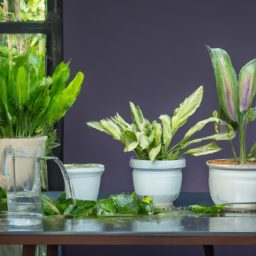
Best Indoor Plants for Division Propagation: Expanding Your Collection
Division propagation is an excellent way to expand your indoor plant collection. It involves separating a mature plant into smaller sections, each with its own root system, to create new individual plants. This method allows you to multiply your indoor plants quickly and easily, providing you with more greenery to enjoy in your home or office.
1. Spider Plant (Chlorophytum comosum)
The spider plant is one of the best indoor plants for division propagation. It is a popular choice among plant enthusiasts due to its easy care requirements and attractive foliage. Spider plants produce long, arching leaves with green and white stripes, adding a touch of elegance to any space.
To propagate spider plants through division, follow these steps:
Step 1: Choose a mature spider plant that has multiple clumps of leaves.
Step 2: Gently remove the plant from its pot, being careful not to damage the roots.
Step 3: Separate the clumps of leaves into individual sections, ensuring that each section has its own root system.
Step 4: Plant each section in a separate pot filled with well-draining soil.
Step 5: Water the newly potted spider plant sections thoroughly and place them in a bright, indirect light location.
Step 6: Keep the soil consistently moist but not overly wet, and within a few weeks, you will notice new growth emerging from each section.
Spider plants are known for their ability to produce “spiderettes” or small plantlets that dangle from the mother plant. These plantlets can be easily separated and potted up to create new spider plants.
2. Snake Plant (Sansevieria trifasciata)
The snake plant, also known as mother-in-law’s tongue, is another excellent choice for division propagation. It is a hardy plant that can tolerate a wide range of conditions, making it ideal for beginners or those with less-than-ideal growing environments.
To propagate snake plants through division, follow these steps:
Step 1: Select a mature snake plant with multiple leaves and a well-established root system.
Step 2: Carefully remove the plant from its pot, gently loosening the soil around the roots.
Step 3: Divide the plant into smaller sections, ensuring that each section has a good number of leaves and roots.
Step 4: Plant each section in a separate pot filled with well-draining soil.
Step 5: Place the newly potted snake plant sections in a location with indirect sunlight.
Step 6: Water the divided sections sparingly, allowing the soil to dry out slightly between waterings.
Step 7: Within a few weeks, new growth will emerge from each section, and you will have multiple snake plants to enjoy.
The snake plant is known for its air-purifying qualities, making it a popular choice for indoor spaces.
3. Pothos (Epipremnum aureum)
Pothos, also known as Devil’s Ivy, is a versatile and low-maintenance indoor plant that is perfect for division propagation. It features heart-shaped leaves that come in various shades of green, making it a visually appealing addition to any room.
To propagate pothos through division, follow these steps:
Step 1: Select a mature pothos plant with multiple vines and leaves.
Step 2: Gently remove the plant from its pot, being careful not to damage the roots.
Step 3: Separate the vines into smaller sections, ensuring that each section has a few leaves and roots.
Step 4: Plant each section in a separate pot filled with well-draining soil.
Step 5: Place the newly potted pothos sections in a location with bright, indirect light.
Step 6: Water the divided sections thoroughly and allow the soil to dry out slightly between waterings.
Step 7: With proper care, new growth will emerge from each section, creating a lush and full pothos plant.
Pothos is known for its trailing vines, making it an excellent choice for hanging baskets or to cascade down shelves or bookcases.
Division propagation is a rewarding and cost-effective way to expand your indoor plant collection. By selecting the right plants and following the proper techniques, you can multiply your green companions and enjoy a thriving indoor garden. Remember to provide the newly divided plants with the care they need, including proper lighting, watering, and occasional fertilization, to ensure their healthy growth.
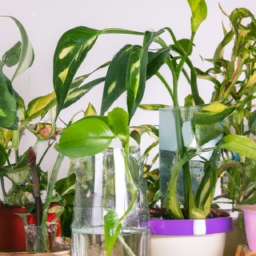
Division Propagation Techniques for Different Types of Indoor Plants
Division propagation is a fantastic method to expand your indoor plant collection. It allows you to multiply your plants and create new ones from existing ones. This technique involves dividing a mature plant into smaller sections, each with its own root system, which can then be potted separately. In this article, we will explore division propagation techniques for different types of indoor plants.
1. Succulents
Succulents are known for their ability to store water in their leaves, stems, and roots. This unique characteristic makes them excellent candidates for division propagation. Here’s how you can propagate succulents through division:
First, carefully remove the succulent from its pot and gently shake off any excess soil. Inspect the plant for any offsets or baby plants that have grown around the base. Using a clean, sharp knife or scissors, carefully separate these offsets from the main plant, ensuring that each offset has some roots attached.
Next, prepare a well-draining potting mix suitable for succulents. Place the offsets in individual pots, making sure to bury the roots in the soil. Water the newly potted succulents sparingly, allowing the soil to dry out between waterings. Within a few weeks, the offsets will develop their own root systems and start growing into independent plants.
Remember to provide adequate sunlight and proper care to your newly propagated succulents to ensure their healthy growth.
2. Ferns
Ferns are beautiful indoor plants that can be easily propagated through division. Here’s a step-by-step guide to propagating ferns:
Start by selecting a mature fern plant that has multiple crowns or clumps. Gently remove the fern from its pot, trying not to damage the roots. Carefully separate the clumps into smaller sections, ensuring that each section has both roots and fronds.
Prepare a potting mix suitable for ferns, preferably one that retains moisture well. Place each divided section into individual pots, making sure to bury the roots in the soil and keep the fronds above the surface. Water the newly potted ferns thoroughly, allowing the soil to stay consistently moist but not waterlogged.
Provide a humid environment for your newly propagated ferns by misting them regularly or placing them on a tray filled with water and pebbles. Keep the pots in a location with indirect light to promote healthy growth.
With proper care and maintenance, your divided ferns will establish themselves and grow into lush, vibrant plants.
3. Spider Plants
Spider plants are popular indoor plants known for their long, arching leaves adorned with small plantlets or “spiderettes.” These plantlets can be easily propagated through division. Here’s how:
Begin by identifying mature spider plants that have produced several plantlets. Gently remove the spider plant from its pot and separate the plantlets from the main plant. Each plantlet should have a few roots attached.
Prepare a well-draining potting mix and place each plantlet in individual pots, burying the roots in the soil. Water the newly potted spider plantlets thoroughly and place them in a location with bright, indirect light.
Spider plants are relatively easy to care for and can adapt to a wide range of conditions. Keep the soil evenly moist but not waterlogged, and provide occasional misting to enhance humidity levels. With time, the plantlets will grow into mature spider plants, producing their own plantlets and expanding your indoor plant collection.
Division propagation is an exciting and rewarding technique that allows you to multiply your indoor plant collection. By following these division propagation techniques for different types of indoor plants, you can enjoy the process of creating new plants while adding beauty and greenery to your indoor space.
Crisp Recap
Division propagation is a simple and effective method to expand your indoor plant collection without spending a fortune. It involves dividing a mature plant into smaller sections and replanting them to create new plants. This technique not only allows you to multiply your collection but also promotes healthier growth and rejuvenates older plants.
To start, choose a plant that is well-established and has multiple stems or clumps. Carefully remove the plant from its pot and gently separate the roots into smaller sections, ensuring each division has enough stems and roots to thrive on its own. Trim any damaged or dead roots before replanting the divisions into their own pots with fresh soil.
Division propagation is particularly beneficial for plants that tend to become overcrowded or develop a dense root system. By dividing them, you not only prevent root-bound issues but also encourage better airflow and nutrient absorption. Additionally, this method is a great way to rejuvenate older plants that may have lost their vigor over time.
Overall, division propagation is a simple and cost-effective way to expand your indoor plant collection while promoting the health and vitality of your existing plants. With a little patience and care, you can multiply your plants and create a lush and diverse indoor garden.
Q1: What is division propagation?
A1: Division propagation is a method of plant propagation where a mature plant is divided into smaller sections, each containing roots and stems, to create new individual plants.
Q2: Why should I use division propagation for my indoor plants?
A2: Division propagation is a great way to multiply your indoor plant collection because it allows you to create multiple new plants from a single parent plant. It is a simple and effective method that can help you expand your collection without having to purchase new plants.
Q3: Which indoor plants can be propagated through division?
A3: Many indoor plants can be propagated through division, including but not limited to snake plants, spider plants, peace lilies, aloe vera, and ferns. It is important to research the specific plant species you intend to propagate to ensure it is suitable for division propagation.
Q4: When is the best time to divide indoor plants?
A4: The best time to divide indoor plants is typically during the spring or early summer when plants are actively growing. This allows the new divisions to establish themselves quickly and adapt to their new environment.
Q5: How do I divide an indoor plant?
A5: To divide an indoor plant, start by carefully removing the plant from its pot. Gently separate the roots and stems into smaller sections, ensuring each division has enough roots and foliage to survive. Plant the divisions in separate pots with fresh potting soil and water them thoroughly.
Q6: Do I need any special tools or equipment for division propagation?
A6: Division propagation can usually be done with basic gardening tools such as a sharp knife or garden shears to separate the plant. It is also helpful to have clean pots, fresh potting soil, and water available for repotting the divisions.
Q7: How long does it take for divided indoor plants to establish and grow?
A7: The time it takes for divided indoor plants to establish and grow can vary depending on the plant species and growing conditions. In general, it may take several weeks to a few months for the divisions to develop new roots and foliage and become fully established.
Q8: How do I care for divided indoor plants after propagation?
A8: After propagation, it is important to provide proper care to the divided indoor plants. This includes placing them in an appropriate location with adequate light, watering them regularly (but not excessively), and monitoring their growth and health. Each plant species may have specific care requirements, so it’s important to research and understand the needs of your specific plants.
Q9: Can I divide an indoor plant that is not doing well?
A9: It is generally not recommended to divide an indoor plant that is not doing well. Division propagation is best done with healthy and thriving plants to ensure the success of the new divisions. If a plant is struggling, it is often better to address the underlying issues causing its decline before considering division propagation.
Q10: Are there any risks or challenges associated with division propagation?
A10: While division propagation is a relatively simple method, there are some risks and challenges to be aware of. Dividing a plant incorrectly or with too much damage to the roots can lead to unsuccessful divisions. Additionally, some plant species may be more sensitive to division and may require extra care during the establishment phase. It’s important to research and understand the specific requirements of the plant species you intend to propagate.
Dr. Olivia Green is a botanist with over two decades of experience in indoor plant cultivation. She holds a Ph.D. in Plant Biology and has dedicated her career to researching plant behavior in controlled environments. Dr. Green is passionate about helping plant enthusiasts master the art of indoor gardening through her extensive knowledge and practical insights.

